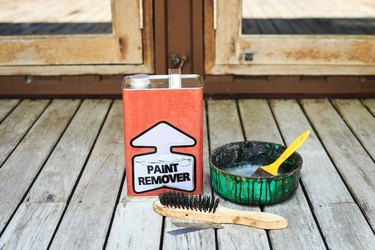
Methyl hydrate is another name for methanol, which is chemically the simplest alcohol. The molecule consists of three hydrogen atoms and a hydroxide radical bound to a single carbon atom. It's a toxic chemical that is sometimes called wood alcohol because it used to be produced from wood.
Methanol is a solvent that you can use to remove dried latex paint, shellac and lacquer. You can buy it in quart and gallon cans at hardware stores, where it is usually labeled methyl hydrate. Painters use it to clean paint off wood because it's safer to handle than paint stripper and has minimal effect on the wood.
Video of the Day
Video of the Day
Rubbing Alcohol for Paint Removal
Rubbing alcohol, like methyl hydrate, is another product you can buy over the counter, although you generally get it at the drugstore, not the paint store. Rubbing alcohol is isopropyl alcohol, also known as isopropanol, which is a larger molecule with a slower evaporation rate than methanol. Both are solvents, and you can use either to strip paint, but methanol is more effective. However, there's a third option that is even better.
Denatured Alcohol for Paint Removal
Ethanol, or drinking alcohol, is a polar molecule, which makes it a better solvent than even methanol, but it's a regulated substance. To sell it legally, manufacturers mix it with methanol and other toxins to make denatured alcohol. If you are committed to alcohol for paint removal, denatured alcohol is the best choice of the three.
Using Methyl Hydrate to Remove Paint
Neither methyl, denatured alcohol or rubbing alcohol will have much effect on dried oil-based paint, but all will, to varying degrees, soften dried latex paint. To strip paint with methyl hydrate, it's best if the solvent is in contact with the paint for a few minutes, but because it evaporates quickly, this can be difficult to do.
One technique is to soak a rag and rub the paint repeatedly. This may take time and patience, but you'll ultimately be successful. This technique is good for painted glass, metal and wood but not for plastic because methyl hydrate can soften plastic.
Another technique is to apply methyl hydrate liberally with a cloth or paint brush and immediately cover it with plastic sheeting to prevent evaporation. Wait 10 or 15 minutes and then scrape or rub off the softened paint.
Use Varsol or Mineral Spirits on Oil-Based Paint
You can't use alcohol to soften oil-based paint, so what can you use? The answer is a variety of solvents including turpentine, mineral spirits or Varsol, which is a pure type of mineral spirits known as white spirits. You can also use any one of these solvents to clean brushes and wipe up spills.
The general technique for removing dried oil-based paint is the same as for removing dried latex paint. Moisten a rag with the solvent and rub. This isn't an efficient way to strip an entire piece of furniture, but it works well for removing paint spots and for stripping small pieces of metal, wood glass or ceramic.
Mineral Spirits vs. Acetone
Acetone is yet another paint removal product you'll find at the paint store. It's a thin, highly volatile and flammable liquid, and it's a common ingredient in lacquer thinner and in nail polish, which is just lacquer. Acetone softens dried lacquer, which mineral spirits won't do, so it's as good as methyl hydrate for removing that type of paint.
To remove dried lacquer, moisten a cloth with acetone and rub the lacquer until it's gone. Acetone is safe for wood, ceramic, glass and metal, but like alcohol, it can damage plastic.